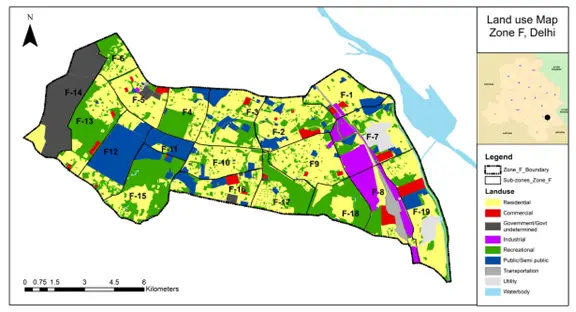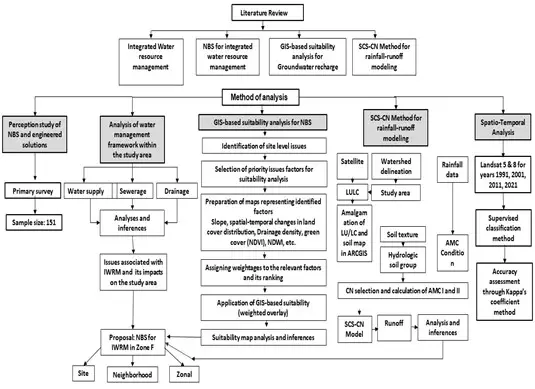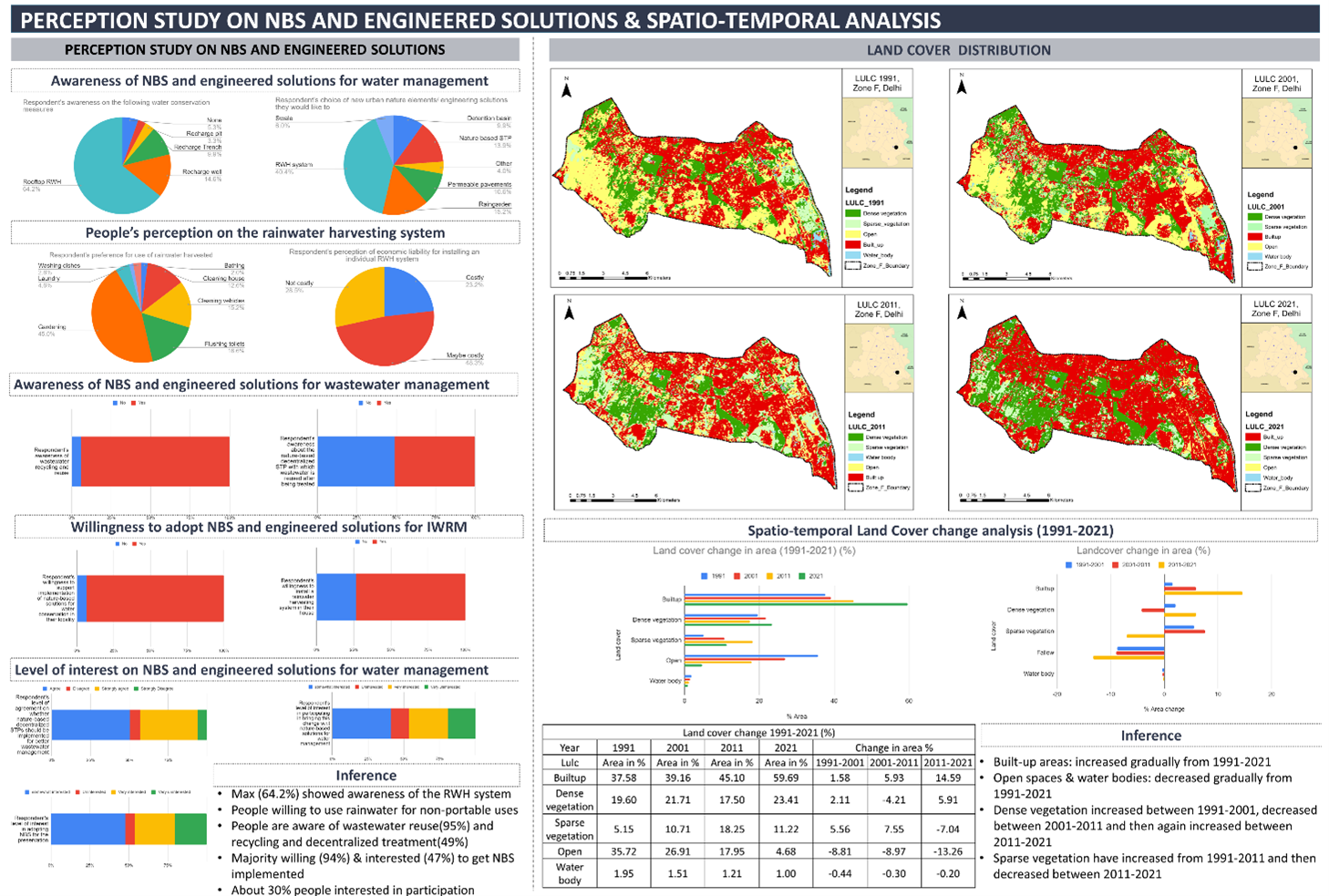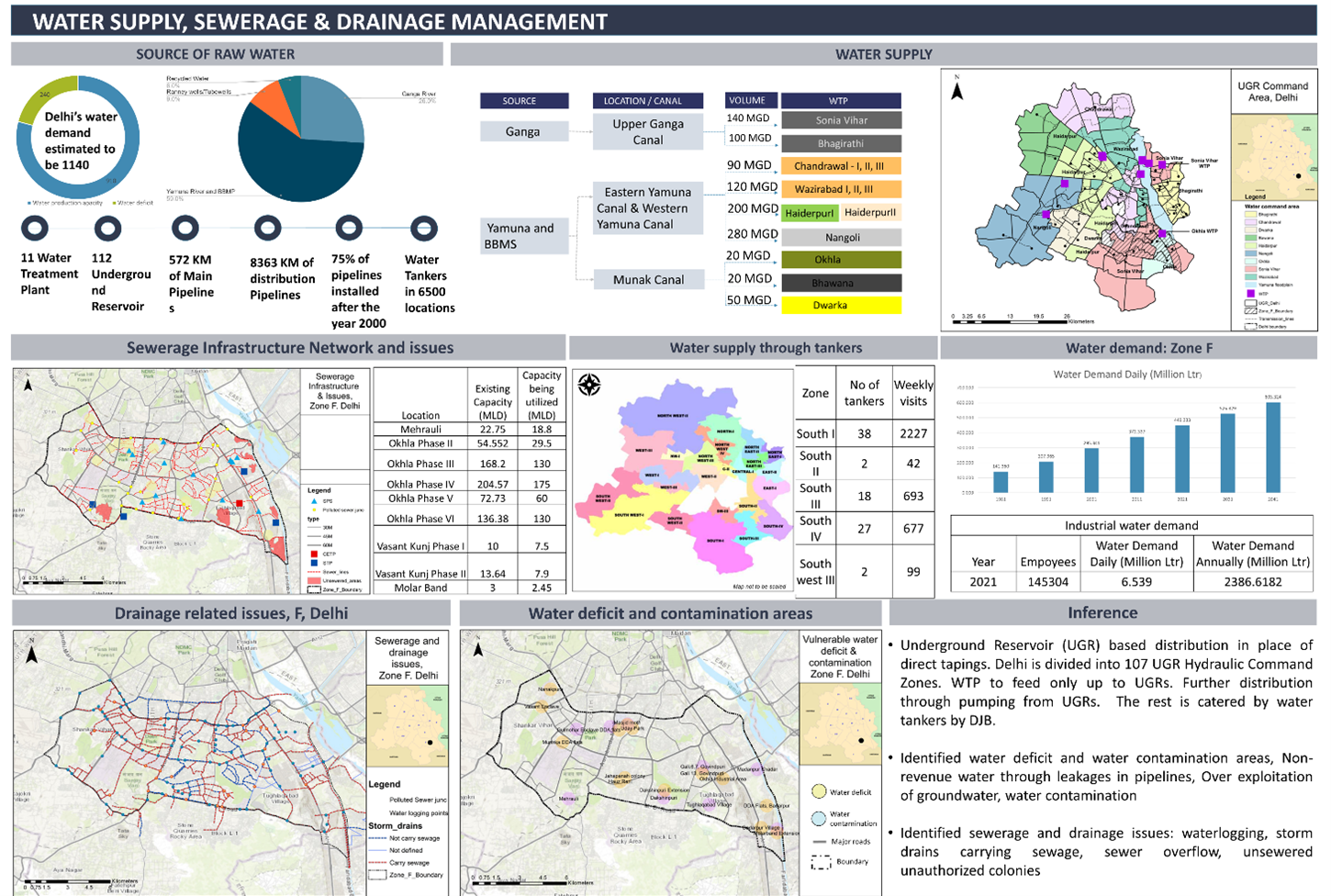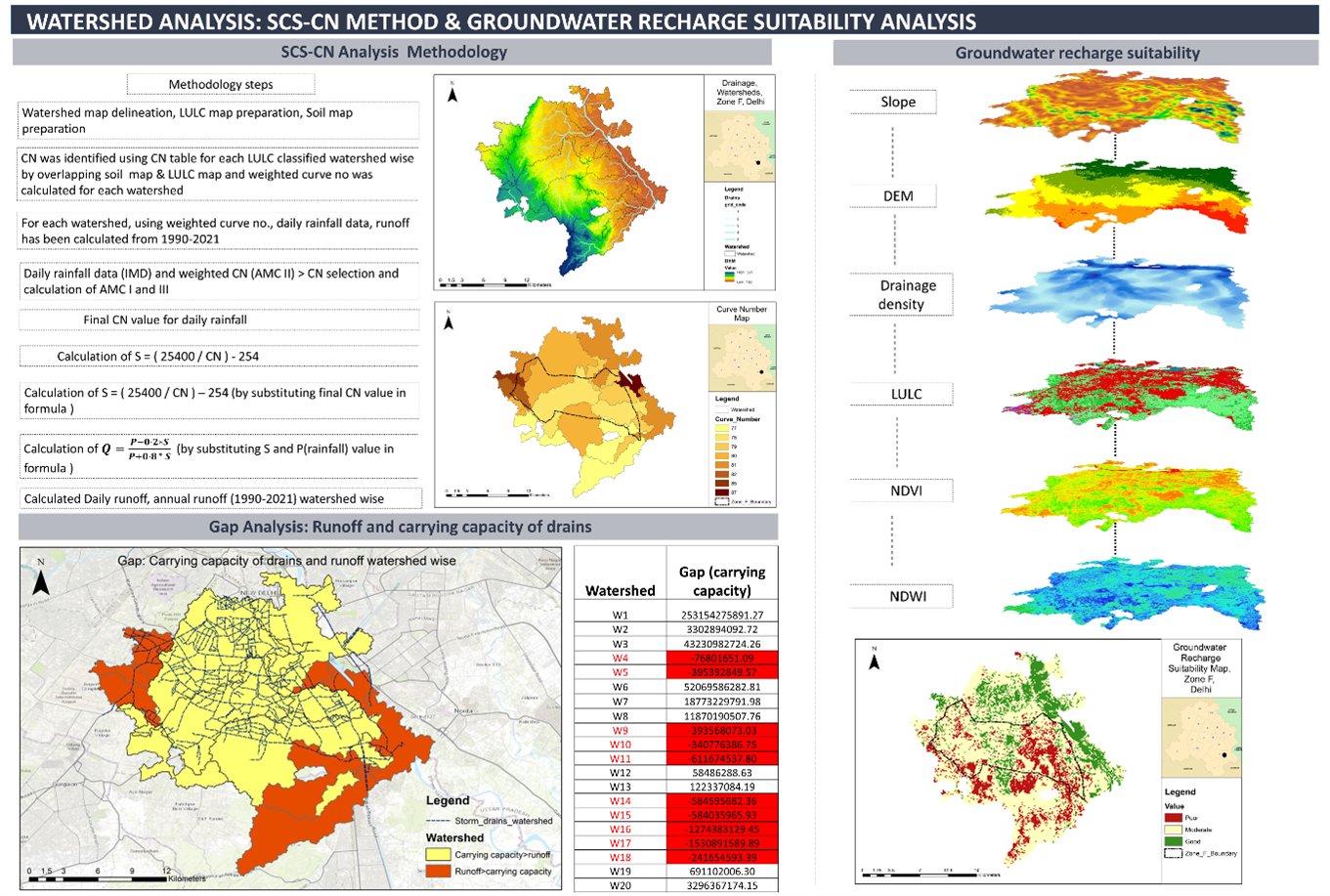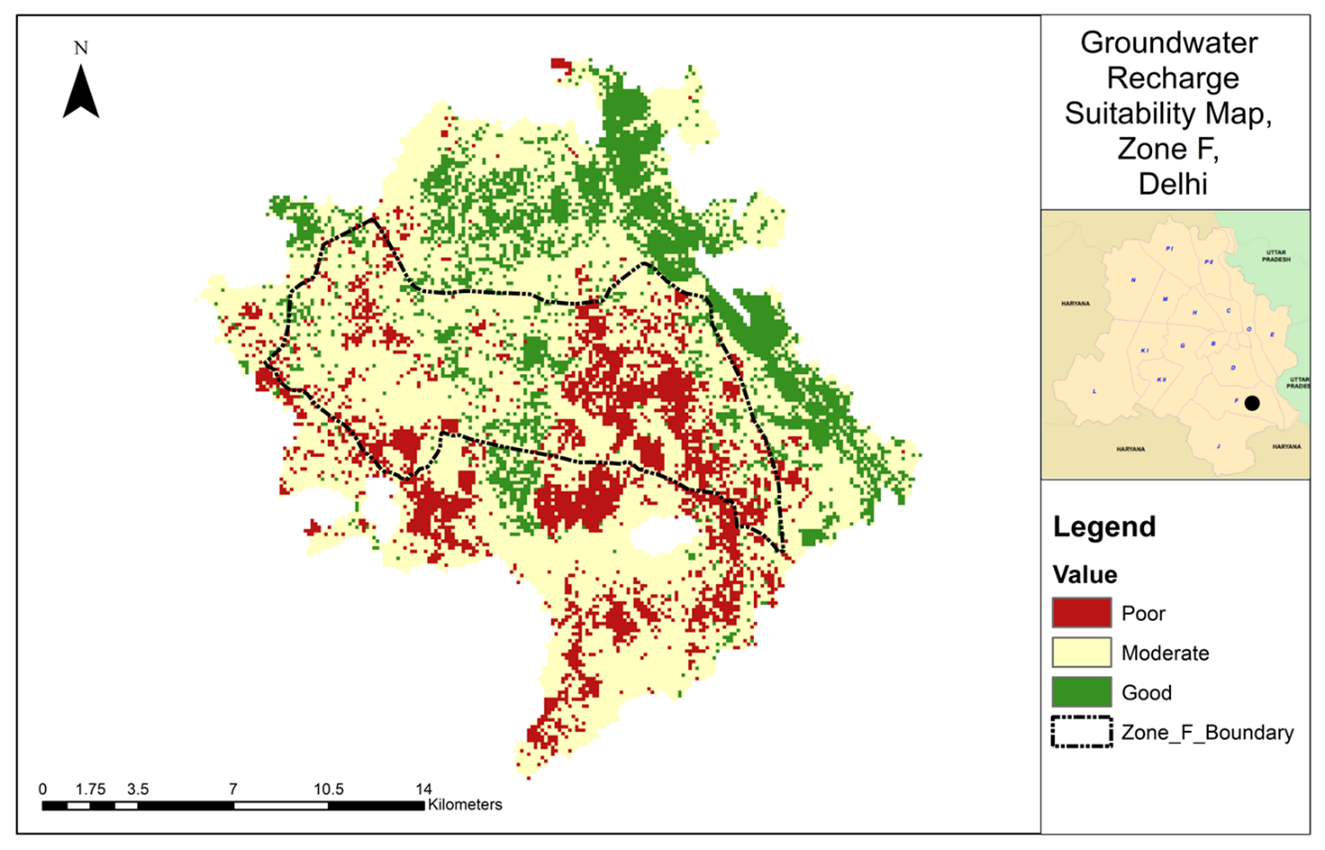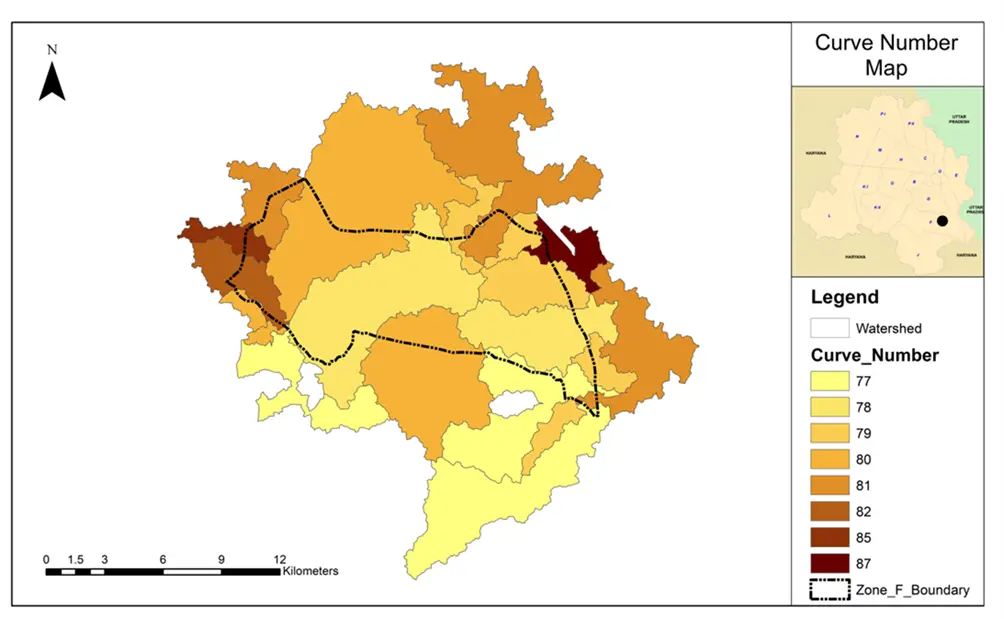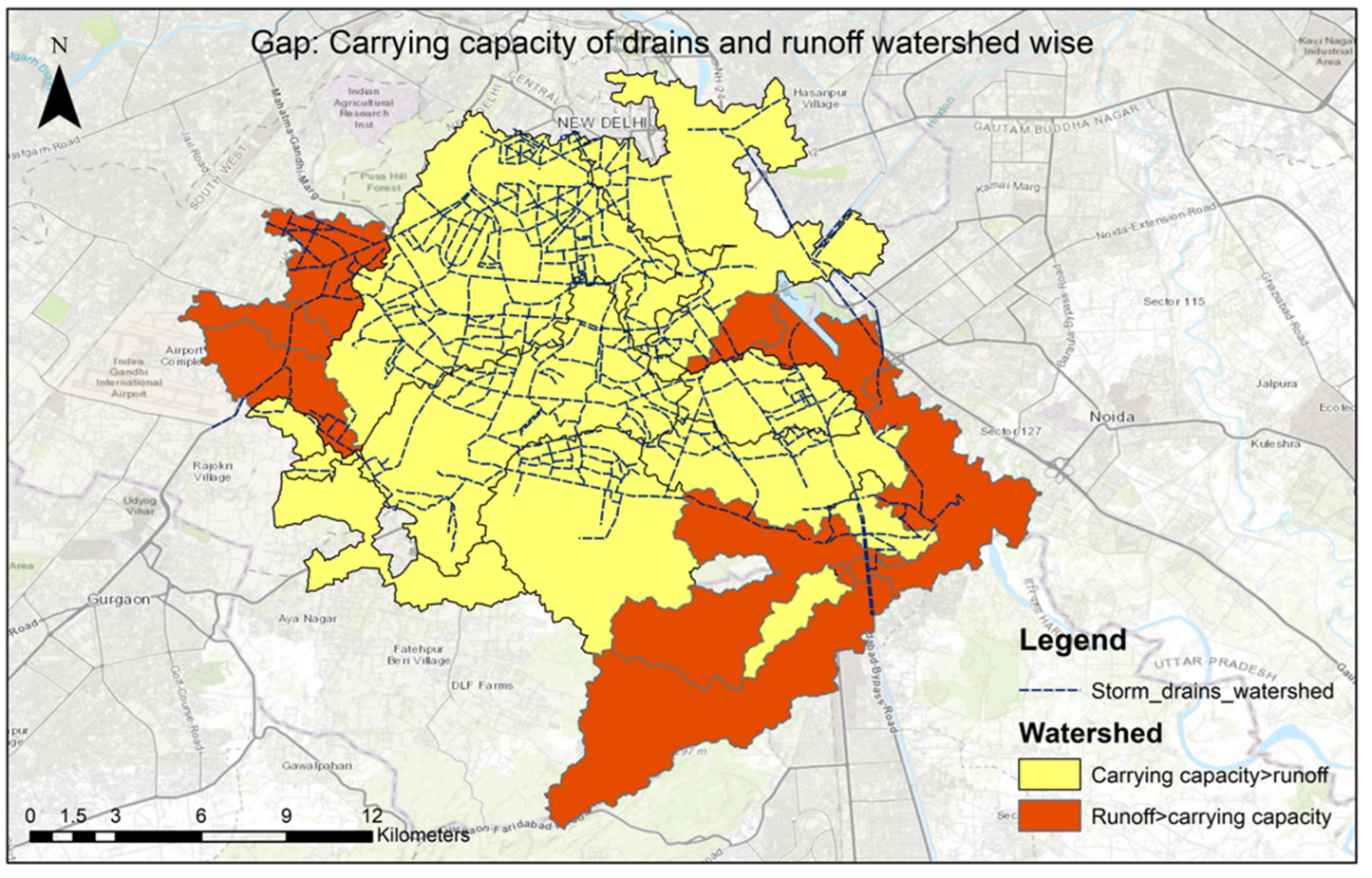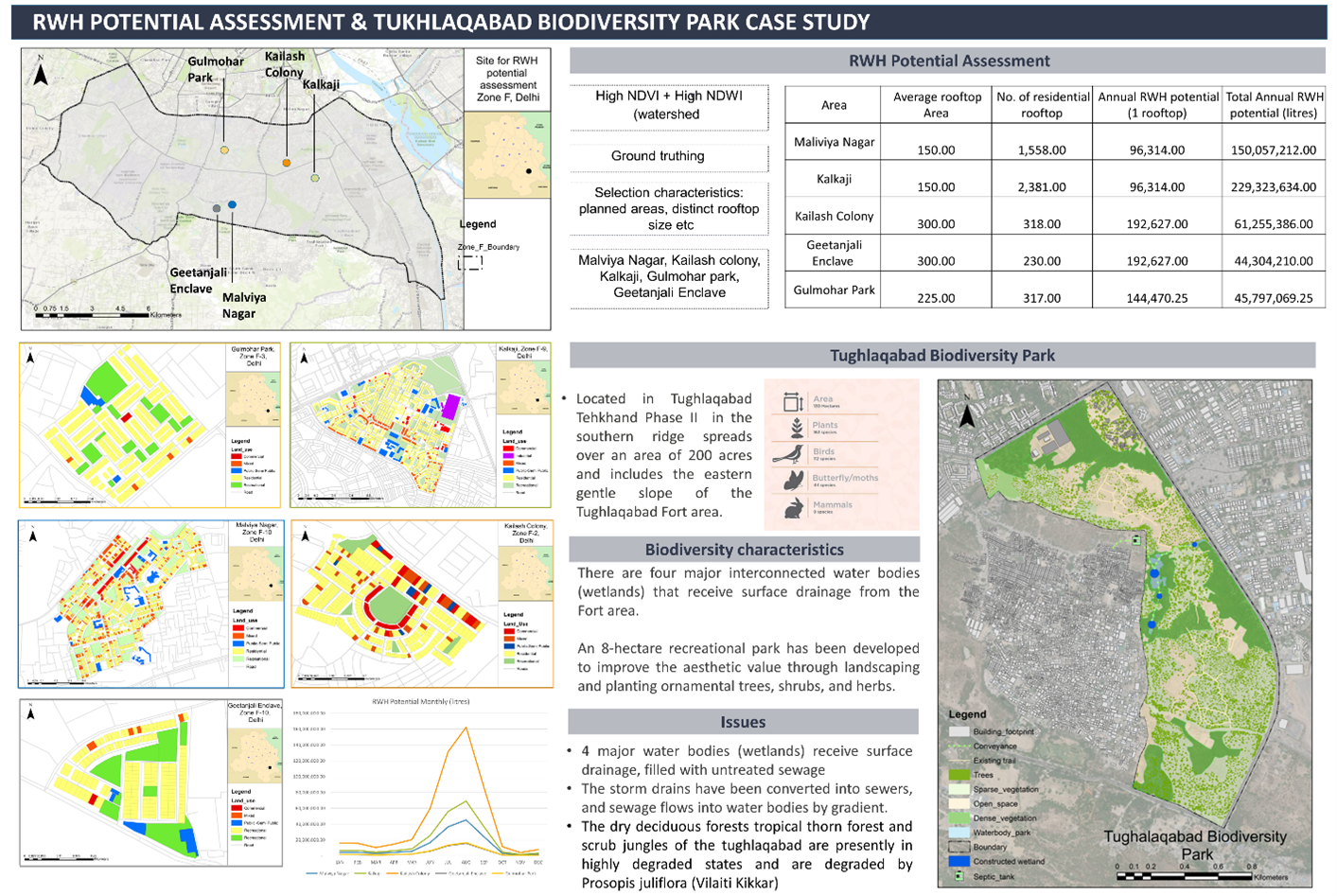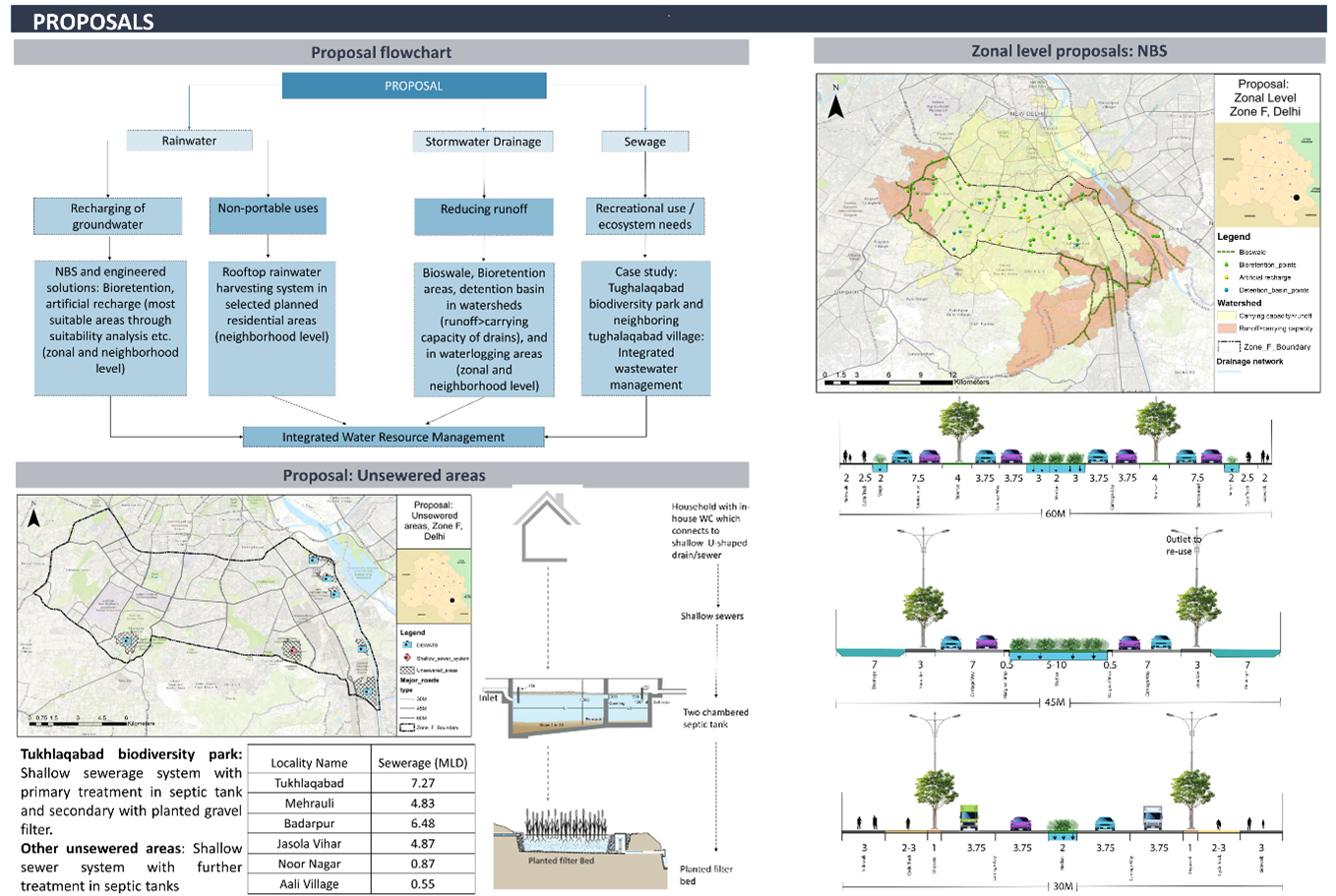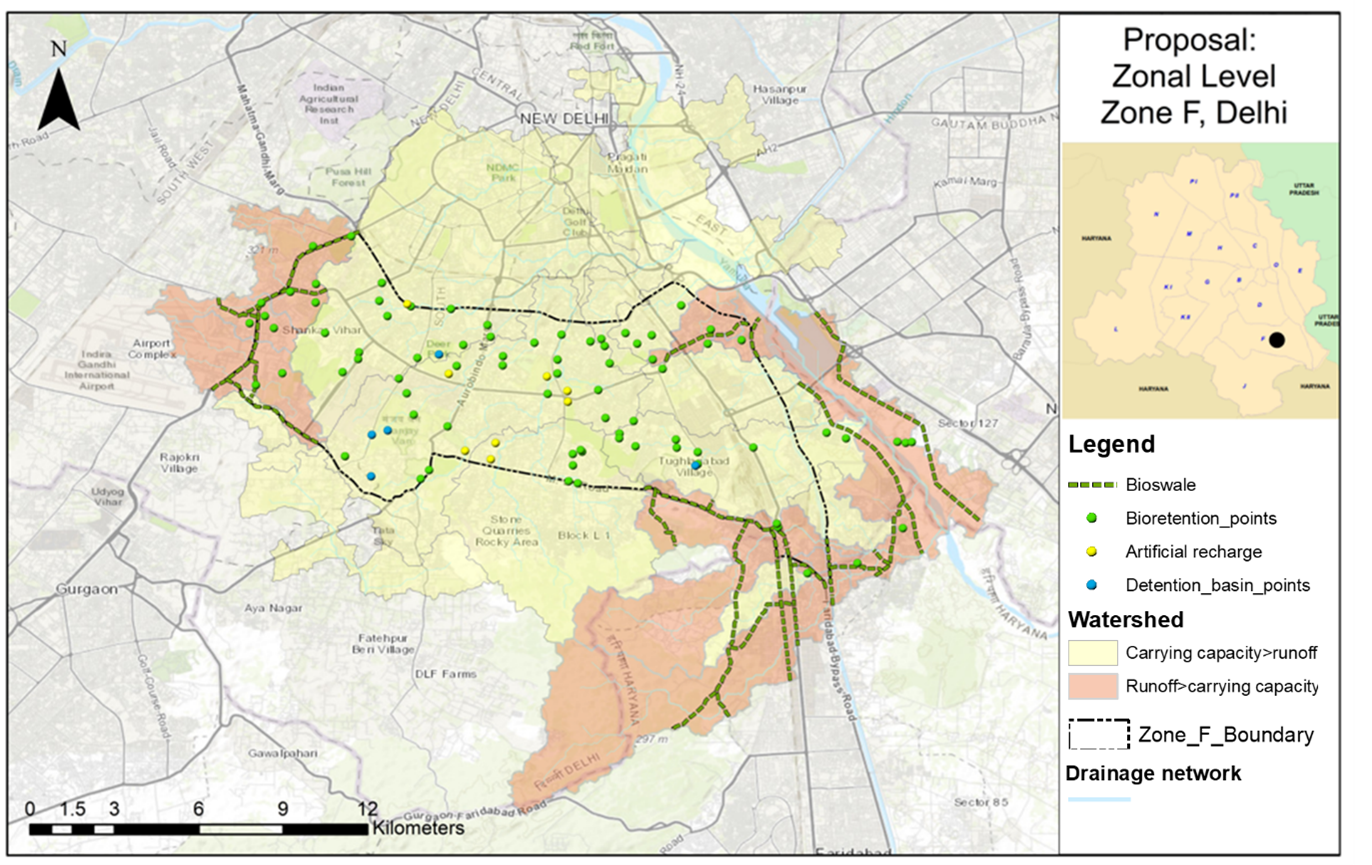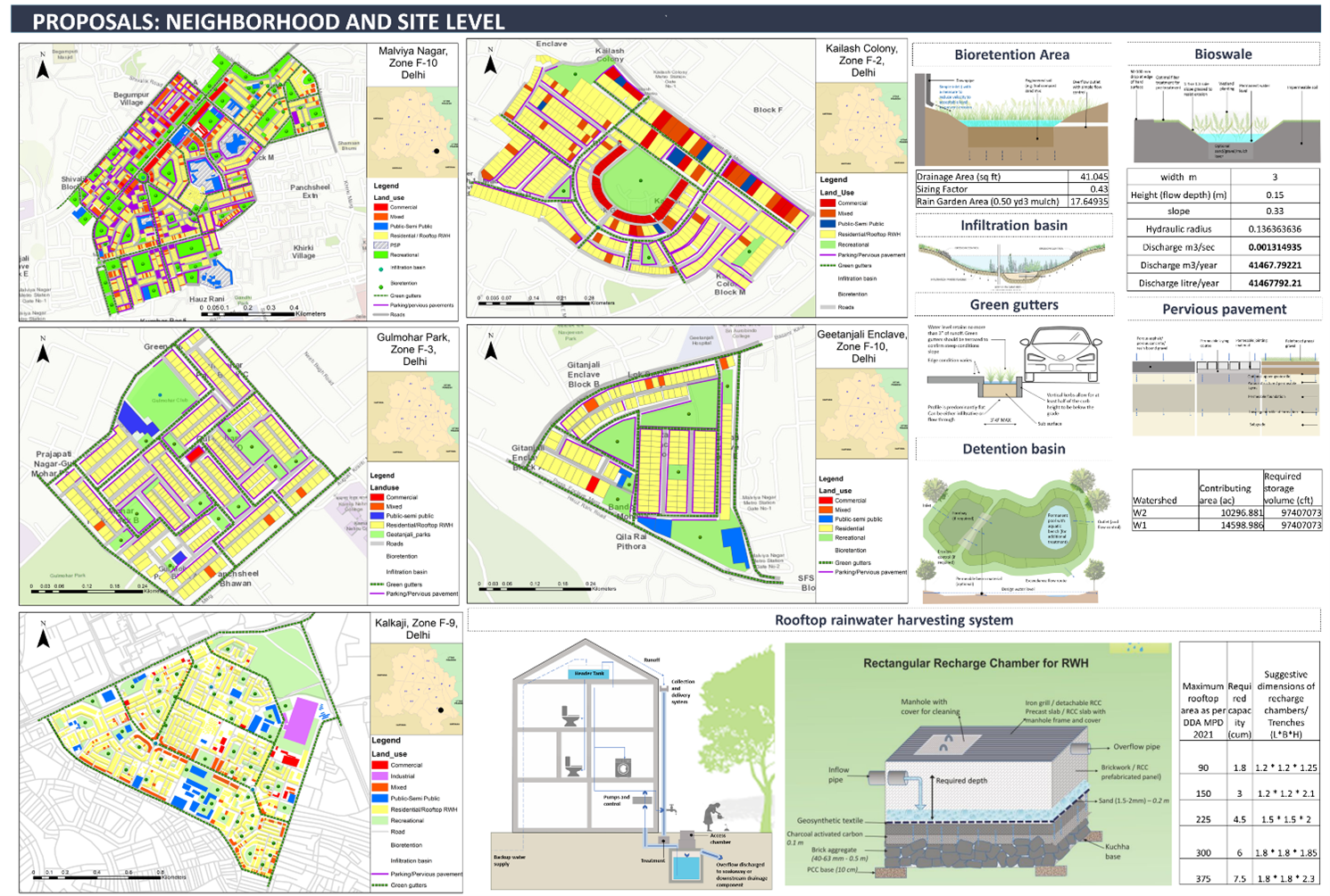Thesis Title: Nature-Based Solutions for Integrated Water Resource Management, A Case of Zone F, Delhi
Category/ Broad Area: Environment
Aim : To assess the potential of Nature-based solutions for integrated water resource management in Zone F Delhi
Objectives:
- To study the characteristics of the watersheds coming within the study area.
- To delineate the watersheds coming within Zone F.
- To analyze Spatio-temporal changes in land-use land-cover distribution within the delineated watersheds
- To explore the existing water management framework within the study area
- To assess the study area’s existing water supply, sewerage, and drainage systems.
- To analyze the issues associated with the water management and its impacts on the study area
- To evaluate the suitability of nature-based solutions for achieving integrated water resource management.
- To propose nature-based solutions for integrated water resource management in the study area.
Scope:
- This thesis will cover the assessment of the potential of nature-based solutions for integrated water resource management within the zone F of Delhi only
- Even if the delineated watersheds partly cover areas outside of zone F, the full extent of the same will still be considered in the study
- In this study, nature-based solutions will be considered in tandem with the engineered solutions to come up with most optimum solutions for achieving integrated water resource management within the study area
Limitations:
- This research work will not cover financial aspects of nature-based solutions.
- For meeting the gap in the quantity of drinking water currently being supplied to Zone-F, only supply centric interventions shall be attempted
- While proposing the nature-based solutions, following aspects would be taken into account:
- Improving the quality of surface runoff and drainage flow
- Identification of suitable locations for achieving ground water recharge through measures such as bioswales, retention basins, percolation tanks, injection wells, permeable pavements etc.
- Calculation of the carrying capacity of the man-made and natural drainage systems
- Identification of suitable locations for siting detention basins for accommodating the excess flow beyond the carrying capacity of the man-made and the natural drainage systems.
- Proposing decentralized wastewater treatment (DEWATS) systems for meeting the gap in the present availability of sewage treatment infrastructure catering to Zone-F
Need for Study
The consumption of water resource would also rise as urban areas are exceedingly dependent on it, be it for domestic or commercial or industrial purposes which are growing over the years. The future calls for a supply of vital resources such as water to be available in abundance for all sorts of needs. Nature-based solutions, a newer concept, are inspired and supported by nature, cost-effective, simultaneously provide environmental, social and economic benefits in water sector. Water plays an essential role in building our cities and the need for nature-based solution in planning smarter cities is crucial. There is a need of new ways to better utilize and manage the limited water resources available. Poor water management can be mitigated using nature- based solutions. Upscaling NBS is a need of an hour which will help in meeting growing water demand, maintaining water quality and availability.
Case Study: Zone F, Delhi
According to Master Plan 2021, the NCT of Delhi has been divided into 15 Planning Zones labelled A to P (excluding Zone I). Zone F is one of the zones which covers an area of 11958 Ha. It is located towards the south of Ring Road from Dhaula Kuan to Maharani Bagh, and to the east of the River Yamuna and the NH-2 by-pass, and lies to the west of Delhi. Cantonment region, Indira Gandhi International Airport, National Highway-8, and Badarpur-Mehrauli-Mahipalpur Road in the south.
The zone features heterogenous character, with unplanned regions coexisting with planned areas created according to the principles of several plans. Zone ‘F’ is distinguished by zone’s low density and greenness. This zone is mostly made up of well-planned, well-kept upscale residential areas. Rehabilitation colonies and government housing developments are also included. There are several established parks, as well as city woodlands and the ridge area. This zone also consists of well-planned areas in terms of residential areas.
The study area Zone F, Delhi has been selected on various geophysical parameters such as green spaces, groundwater conditions, flooding hotspots, runoff potential etc. Groundwater condition of zone F is under semi-critical to over exploited as per central ground water board, 2016 Low groundwater levels (range -20 to -40) metre below ground level which shows necessities the exploration for groundwater recharge within the study area. There are large number of green spaces in zone and there are high water logging hotspots as identified by traffic police and drainage master plan in zone F. Apart from these aspects, according to CSE, 2020, South Delhi zone has the highest annual runoff potential including zone F.
Significance/usefulness of the project
Due to the country’s water challenges, research on nature-based solutions for integrated water resource management is critical in India. Both conventional and natural infrastructure are essential for effective and sustainable water resource management. Nature-Based Solutions addresses scarcity, floods, and droughts by implementing practices such as watershed management and afforestation. Nature-based solutions improve water quality by restoring ecosystems such as wetlands and forests, thereby promoting biodiversity conservation. The importance of community involvement in water management and climate change adaptation is emphasized, promoting long-term strategies. NBS are essential for holistic and resilient water management in India due to their cost-effectiveness and role in informing policy. Nature can provide answers for water security if we account for its services and invest appropriately. Nature-based solutions for integrated water resource management have been addressed in SDG 6, guaranteeing sustainable water management, which includes an integrated water resource management approach. Overall, this research ensures that human needs, environmental preservation, and long-term water resource sustainability are all balanced.
Abstract:
Water is a crucial economic and social growth engine and a fundamental function in sustaining the natural environment’s integrity. Water is becoming increasingly scarce. Our current pace of water usage is unsustainable. Demographic and climatic changes, for example, exacerbate the stress on water supplies. The world’s population has tripled in the previous century, along with water consumption which has increased sixfold. Global water consumption is anticipated to increase by more than 50% by 2030, owing to increased irrigation, groundwater extraction, changing diets, rising energy needs, and a changing climate. This will result in severe water shortages. Pesticide usage, salinization, industrial waste, and municipal sewage results in the degradation of water quality. These factors will combine to cause urban water problems. The traditional fragmented method of water management is no longer efficient on its own, necessitating a more holistic approach to water management. This is the reasoning behind the Integrated Water Resources Management (IWRM) approach, which is today regarded as the best strategy for the efficient, equitable, and long-term development and management of the world’s finite water resources, as well as for balancing opposing demands. Nature has an important role in achieving IWRM: protecting water resources by controlling water flow, guaranteeing water quality, and mitigating the effects of natural disasters. Wetland, woodland, mountain, and grassland habitats are especially essential. It is not a standalone solution instead; it can be used effectively with engineered solutions known as the grey-green approach toward water resource management. There are four major requirements to be fulfilled to achieve IWRM which can be achieved through nature-based solutions: augmenting the quantity of water supplied through groundwater, aquifers restoration, reducing/eliminating the number of pollutants in water, number of ecosystems reconnected which will eventually reduce the number of conflicts due to water insecurity.
Literature Review and Methodology
First, the literature review on Integrated water resource management, Nature-based solution for IWRM, GIS-based suitability analysis for green infrastructure, SCS-CN Method for rainfall-runoff modeling, Spatial-temporal analysis would be studied. Data on water supply, sewerage, and drainage of zone F, Delhi has been collected from the respective sectors.
The following methods are chosen for the research based on a review of the literature:
- Perception study on water conservation measures (Nature-based solutions and engineered solutions) was undertaken to understand citizens’ perspectives on the same.
- SCS- CN Method was used for runoff-rainfall modeling and identifying gaps in the carrying capacity of drains and runoff within watersheds.
- GIS-based suitability analysis for groundwater recharge/ green infrastructure using weighted overlay was done for identifying potential areas for artificial recharge and water management framework of the study area, including biodiversity aspect was studied and issues associated with them were identified.
- Based on inferences and analysis, the expected outcome would be proposals on nature-based solutions and engineered solutions on three levels site, neighborhood, and zonal.
Figure 1. Thesis Methodology
Figure 2. Perception study on NBS and Engineered Solutions & Spatio-Temporal Analysis
Perception study on water conservation measures (Nature-based solutions and engineered solutions)
The method which was taken into consideration for the study is a qualitative study in which 151 sample size was taken taking confidence level 95% and error 8%, 5-6 samples were taken from each watershed coming within the study area. In the primary survey conducted, the respondents were asked about their perception, awareness of water conservation measures both nature-based and engineered solutions and their willingness to accept them.
Figure 3. Water Supply, Sewerage & Drainage Management
Water resource management Framework Analysis within the study area
The following is the methodology used in this study:
- Collection of data on water supply, drainage, sewerage, and solid waste management of the study area.
- Analysis of the data collected
- Taking inferences and identification of issues related to integrated water resource management within the study area
- Based on issues identified, the gap would be filled by proposals on nature-based solutions within zone F, Delhi.
Figure 4. Watershed Analysis: SCS-CN Method & Ground Recharge Suitability Analysis
Figure 5. Groundwater Recharge Suitability Map
Figure 6. Curve Number Map (Watershed Wise)
Figure 7. Map showing Watershed Carrying Capacity of drains VS Runoff
SCS SN Method of rainfall-runoff modeling
The Soil Conservation Service (Soil Conservation Service 1964; 1972) developed the Curve Number Method for conditions prevalent in the United States. It has been accepted widely in the world for runoff rainfall modeling. For each watershed, using weighted curve no., daily rainfall data, runoff has been calculated from 1990-2021. Annual runoff watershed wise (watershed 1-20) was finally calculated. The map below shows graduated colors of watersheds from lower to higher curve number calculated.
Carrying capacity of drains within each watershed has been calculated using Manning’s formula. Then, Gap analysis was done by subtracting runoff from carrying capacity of drains of respective watersheds. The negative sign indicated runoff is greater than the carrying capacity of drains. The highlighted watersheds with red are the ones in which the runoff is exceeding the carrying capacity of the existing drains found in the gap assessment of runoff and carrying capacity assessment using SCS-CN method and manning’s formula respectively.
GIS-Based Suitability Analysis for groundwater recharge
The method which was taken into consideration for GIS-based suitability analysis is as follows:
- Mapping of various geophysical layers such as slope, drainage density, DEM, Curve number, runoff depth, runoff volume, soil, NDVI, NDWI.
- Assigning weights to the relevant factors and their ranking based on the assigned importance
- Application of GIS-based suitability (weighted overlay) in which integration of surface geophysical features mentioned such as DEM, Curve Number, runoff depth, runoff volume, soil, etc. indicates groundwater potential of the area.
- Following the weighted overlay method, A final groundwater potential map (Suitability map) would be generated by integrating the various thematic maps which would be showing the prospect groundwater potential zones for nature-based solutions.
- Suitability map analysis and inferences
Figure 8. RWH Potential Assessment & Tukhlaqabad Biodiversity Park Case Study
RWH Potential Assessment & Tukhlaqabad Biodiversity Park Case Study
The area selection for the rooftop harvesting potential was based on the selection of the watershed having high NDVI and high NDWI. Further, the areas within the selected watershed are based on planned developed residential areas which are Malviya Nagar, Kailash colony, Kalkaji, Gulmohar park, and Geetanjali Enclave, and also based on different size of rooftop size availability. The following map shows the selected areas based on high NDVI, NDWI, distinct rooftop sizes, and availability of space for storage structures in zone F, Delhi.
Shallow sewers have been proposed for unsewered areas of Tughlaqabad biodiversity park. They are intended to collect residential sewage for treatment and disposal off-site which has also been adopted by CSE. They are proposed to solve the following challenge faced by biodiversity park:
- Surface drainage carries untreated sewage into four large bodies of water (wetlands).
- Storm drains have been transformed into sewers, and sewage flows into bodies of water via gradient.
Figure 9. Proposal flowchart and Zonal Level Proposals
Figure 10. Zonal Level Proposals
The outcome of the thesis is the identification of potential sites for nature-based solutions and proposals for the same at three scales – site, neighborhood and zonal.
At the zonal level, bioswales are being proposed in those watersheds whose runoff is greater than the existing carrying capacity of drains of respective watersheds to cater to the excess runoff of the watershed. Apart from this, Bioretention areas have been demarcated in existing parks under government ownership. Detention basins have been proposed in existing water bodies in the study area to cater to the excess runoff. Through identification of the most suitable location for artificial recharge through GIS-based suitability analysis for groundwater recharge, the most suitable locations have been proposed for artificial recharge zones.
Figure 11. Neighborhood and Site Level Proposals
At the neighborhood level, The selected for rainwater harvesting assessment has been taken into consideration which are Malviya Nagar, Kailash Colony, Gulmohar Park, Geetanjali Enclave and Kalkaji, planned residential areas of zone F, Delhi. The proposal includes the following: 10-15% of parks to be converted to Bioretention areas, infiltration basin in the roundabout present in the locality, green gutters in the major roads.
At site level, rainwater harvesting system has been proposed in the residential plots of areas selected for rainwater harvesting potential in the study area which are Malviya Nagar, Kailash Colony, Gulmohar Park, Geetanjali Enclave and Kalkaji. The proposed rainwater harvesting structure is a pumped rainwater harvesting system.
Keywords: Nature-Based Solutions, Integrated Water Resource Management, Water Scarcity, Water Quality, Urban Water Problems, Green-Grey Approach.
Author: Shweta Pursuing M.Plan Urban Planning at SPA Delhi, (B.Plan, SPA Bhopal).
Guide – Govind M.P, Assistant Professor, Department of Planning, SPA Bhopal
College – School of Planning & Architecture, Bhopal
Declaration by Author: I have authorized Planning Tank to publish this information and the thesis is a work done by (Shweta) and Planning Tank is not responsible for any information presented.
Declaration by Planning Tank: The information presented is provided by the author with no inputs from Planning Tank. Author has conducted the above stated study and can be contacted for more information. Planning Tank is authorized to contact the author if more information is required about the research work for information author about job opportunities and other purposes.
